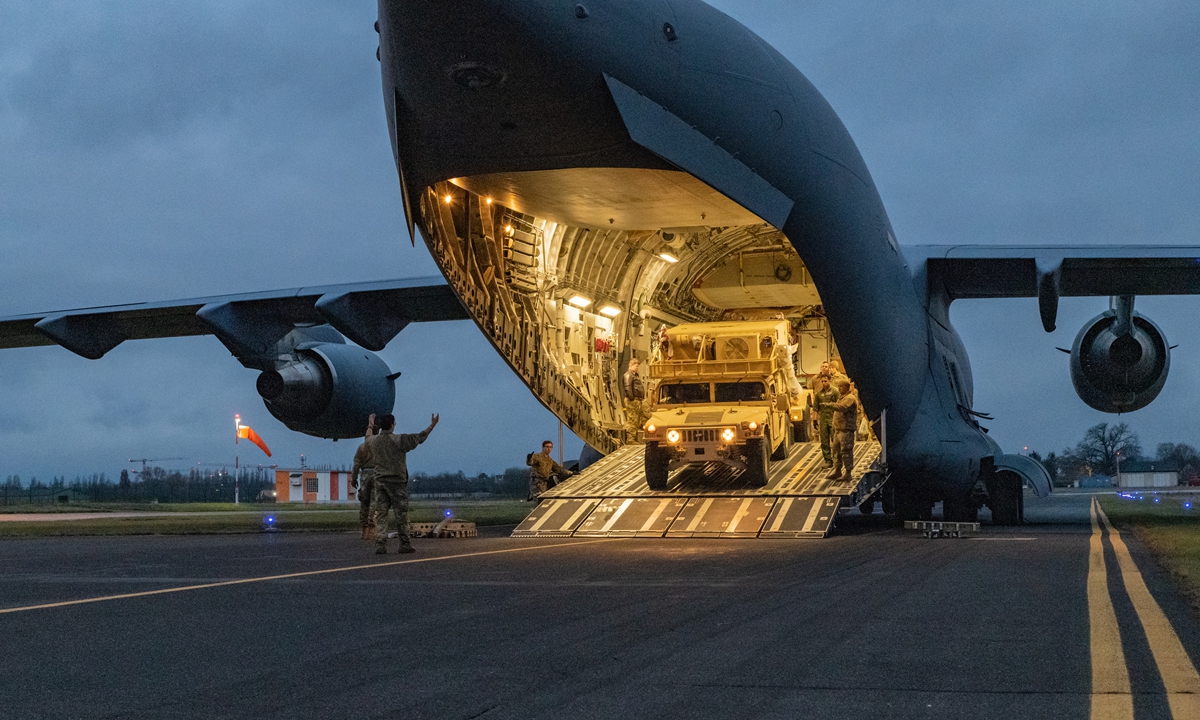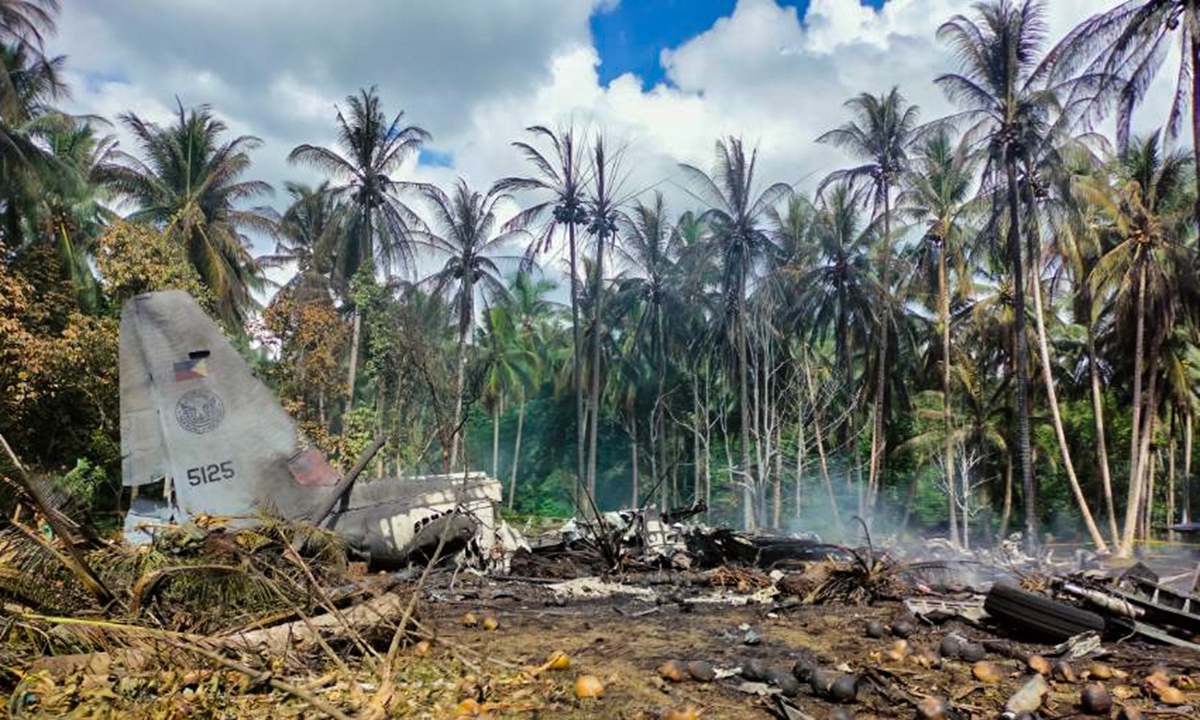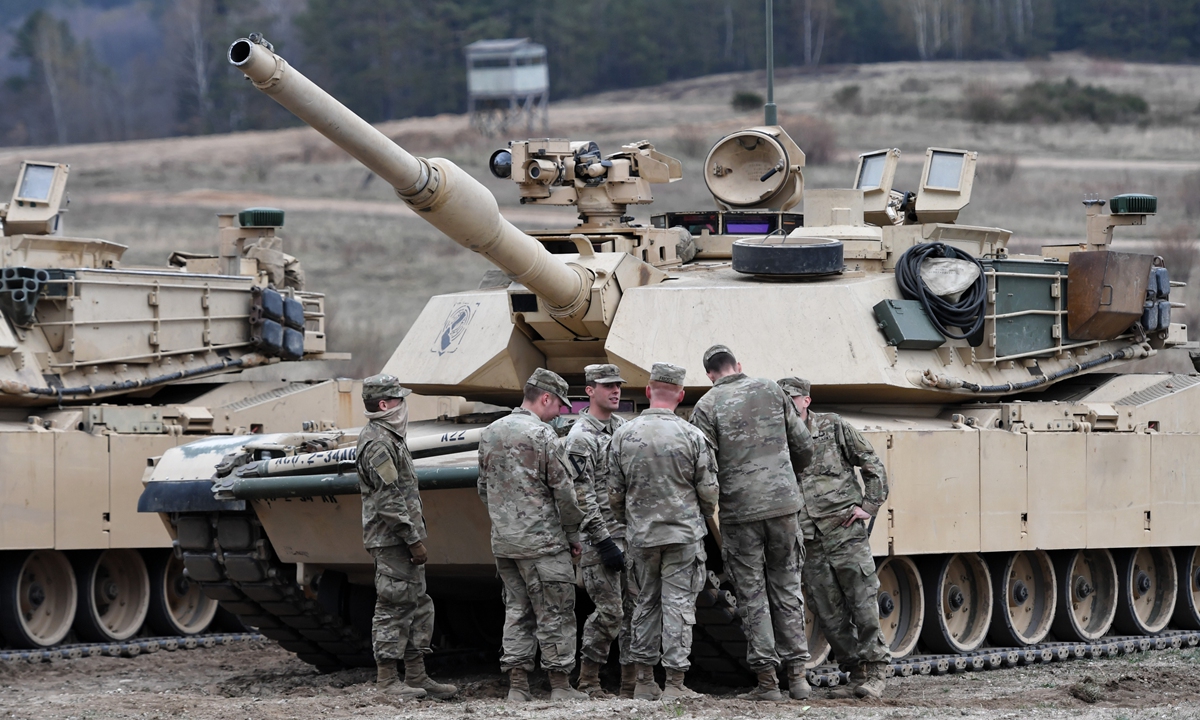Editor's Note:At the US-ASEAN Summit held earlier this month, US President Joe Biden promised to enhance security cooperation with Southeast Asian countries with an obvious intent to actively rope in ASEAN member states into the malicious US strategy of containing China. Over the past decade under banners like the Pivot to Asia and the Indo-Pacific Strategy, the US has been using arms sales, most of them second-hand, as bait to expand influence and infiltrate Southeast Asian countries. Taking a look around the world, retired US military weapons have been scattered around the globe, which has not only greatly profited the US and served as a tool to interfere in regional affairs, but have also brought about a wide range of security risks to users and even leak into black markets and ended up in the hands of terrorists and criminals.

A contingency of American soldiers bringing military equipment to support NATO allies in Eastern Europe arrive in Germany on February 6, 2022. Photo: VCG
Second-hand weapons bring troubles worldwideThe US has established a military alliance system around the world, which is a key foundation to the US military's global hegemony. But not all US partners enjoy the privileges of having access to the most advanced US technologies like nuclear-powered submarines, hypersonic missile, or AI like the members of AUKUS do, as most of them could only acquire retired, second-hand US equipment, military experts told the Global Times on Sunday.
After Iran shot down a US military RQ-4 Global Hawk in 2019, exposing the drone's weaknesses in aerial survivability, the US was eager to retire this outdated piece of equipment and chose Japan from which to make the maximum profit. The acquisition cost Japan 61.3 billion yen ($528 million,) while operation and maintenance expenses amount to 13 billion yen annually, Kyodo News reported in January.
South Korea is also a victim of second-hand US weaponry. The South Korean administration of former President Park Geun-hye purchased more than a dozen Chinook CH-47D helicopters at a hefty price tag of $130 million from the US military, but the choppers were 45-year-old models that were neither equipped with navigation nor missile warning systems, UPI reported in 2017.
In addition to using second-hand weapons to earn unimaginable profits, the US also uses them to stir up troubles around the world and serve its geopolitical goals, experts said.
A direct trigger of the Ukraine crisis is the US' repeated provocations against Russia's security bottom line, experts said. In 2017, the US approved the sale of 210 Javelin missiles and 37 launchers to Ukraine, which were delivered in April 2018, the Washington Post reported. These weapons came from the US military's decommissioned reserves, and all of the US military's Javelin and Stinger missiles decommissioned reserves were cleared after the conflict between Ukraine and Russia broke out, forcing the US military to use its active reserves to aid Ukraine, reports said.
Military aid from the US and its allies has led to a prolonged conflict, deeply impacting the status of regional security and the global strategic pattern.
The US also kept providing arms to the island of Taiwan, despite saying it does not support "Taiwan independence." Outdated US weapons like Kidd-class destroyers and Perry-class frigates were delivered to the island of Taiwan at very exorbitant costs.
Some other more advanced weapons the US has provided to the island of Taiwan are also in need of scrutiny, analysts said. The US approved a $2.2 billion arms sale to the island which included 108 M1A2T Abrams tanks plus related equipment in 2019, CNN reported. But analysts said that they are overpriced, and such a type of heavy tank is unlikely to be compatible with island terrain in the first place.
The US has always been known to develop the most advanced weapons in the world. Some of its outdated weapons remain top class in the eyes of some countries and regions and it is therefore supposed to be a good bargain if the US sells them to those in need at discounted prices. However, US arms sales always come with political strings attached, a Chinese military expert told the Global Times on Sunday.
Technical issues are another key problem in second-hand US weapon sales. Some 53 people were killed and another 50 injured when a Philippine Air Force C-130 transport plane crashed in the southern Philippines in July 2021, marking it the country's worst military air disaster in 30 years. The 33-year-old second-hand aircraft had been delivered by the US five months earlier, the Xinhua News Agency reported. The air forces of Thailand and Indonesia have also suffered a number of accidents caused by the use of second-hand F-16 fighter jets provided by the US.

A Philippine Air Force C-130 transport aircraft provided by the US crashes in the southern Philippines in July 2021, killing over 50. Photo: Xinhua
The US also charges high prices for the maintenance of these old weapons, as only the US manufacturers have spare parts, Xinhua quoted Thai and Indonesian experts as saying.
India has long used Russian weapons and equipment, but the US has eagerly and continually attempted to promote its wares to the country and replace the Russian ones. In the process, India reportedly bought many second-hand US weapons, like 24 MH-60R Seahawk multi-mission helicopters at a whopping $2.6 billion in 2019 and extreme cold weather insulation clothing that was later reported by Indian soldiers as being second-hand.
While the US sells these weapons often under the name of safeguarding peace, it is hoping to create more wars so US arms dealers can earn more money. From the War in Afghanistan to the Syrian Crisis; from the Israeli-Palestinian conflict to the Russian-Ukrainian conflict, US arms firms and politicians have always been there, reaping whatever they can, at the cost of fear, homelessness, and the death of local people, experts said.
Irresponsible transfers empower terrorists, criminals
In its arms sales, the US often attempts to control the users. For instance, The US sold dozens of F-16 fighter jets to Pakistan in 2006, but as part of the purchase agreement, the US placed certain restrictions on how its military equipment can be used, CNN reported. It is unclear what restrictions were put in place on the use of Pakistan's F-16 jets, but the US looked into reports that Pakistan "misused" the F-16s during an aerial engagement with India in early 2019.
Another example is that the US kicked Turkey out of the F-35 joint strike fighter program in 2019 after Turkey accepted the S-400 air defense system from Russia, US media Defense News reported. The Russian platform can be used to learn about the F-35's capabilities, the report quoted the White House as saying.
However, the US has failed to control all of its weapons transfers when it has really mattered, and some of them have ended up on the black market, eventually falling into the wrong hands including those of terrorists and criminals, bringing more security risks to the whole world, experts said.
Citing a report by Conflict Armament Research, an independent arms-tracking organization, NBC News reported in 2017 that some weapons bought by the US military in 2015 ended up in the hands of ISIS fighters. Under at least two different programs, the US government has supplied weapons to Syrian armed groups, first to fight the Assad government and later to assist the Syrian Democratic Forces (SDF) in the fight against the Islamic State. But in one case, an anti-tank missile sold to the US Army made its way to ISIS in just 59 days, the report said.

US soldiers gather during preparations to train Polish crew members on Abrams tanks at the training ground in Drawsko Pomorskie, Poland on April 25, 2022. Photo: IC
Another report by CNN in 2019 said that US weapons provided to Saudi Arabia and its coalition partners made their ways to al Qaeda-linked fighters. This included assault rifles and anti-tank missiles potentially, according to the report.
In Papua New Guinea, which has received over $1.4 million in US firearm sales since 2009, thousands of small arms, including American M-16 rifles, have found their way to illegal mobs and militias, amplifying intertribal violence and causing thousands to flee their homes, according to a report by the Cato Institute, a Washington-based think tank, in 2021.
At a time when a flood of weapons from the US and its allies are heading to Ukraine amid the ongoing conflict there, vague US assurances have, once again, begun to spark concern about lost military equipment in Ukraine, a longtime hub of arms trafficking, an article in the Washington Post said earlier this month.
In the past few decades, "neo-Nazism" deeply entangled with populism and racism has grown across Eastern Europe, including in countries like Ukraine, under the guise of the protection of so-called freedom, democracy, and human rights of the West, poisoning society and causing violence, hatred, and turmoil, observers said.
Irresponsible arms sales can empower criminal gangs, unregulated militias, and terrorist organizations, contributing to increased violence, the erosion of law and order, and economic disruption, the Cato Institute said.
The US must reflect on its arms sales strategies and approaches if it is really to contribute to world peace, experts told the Global Times on Sunday.






